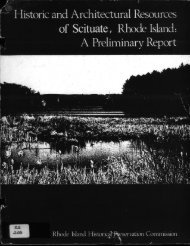1 Dr. Jonathan Prude, Emory University “The Great Transformation ...
1 Dr. Jonathan Prude, Emory University “The Great Transformation ...
1 Dr. Jonathan Prude, Emory University “The Great Transformation ...
You also want an ePaper? Increase the reach of your titles
YUMPU automatically turns print PDFs into web optimized ePapers that Google loves.
10priority of profits. And facilitated where needed by technological innovations, as well as by hopeindustrial manufacturing could benefit rural communities, the lure of earning profits frommaking shoes, hats, or textiles prompted substantial industrial development in the southern NewEngland countryside. By 1819, as many of you know, there were 40 textile mills running off thePawtuxet River alone; and by 1832 the Blackstone was driving 119 such factories. One mighteven argue that over time some of the skepticism directed toward the changes wrought by ruralindustrialization devolved into merely ventings of nostalgia that gave country folk psychologicalcover to accept the inevitability of these changes. Yet the skepticism did not vanish. It wasbraided into the atmosphere of the period. And as such it ensured that at deep levels the responseto industrialization percolating in the milieu and enveloping what happened in southern NewEngland remained mixed: approval blended with measures, at least, of abiding doubt.But then what did happen in these communities? To say industrialization in these settingswas framed by a surrounding context of acceptance and ambivalence begins to shed light onwhat transpired. But we need to dig further. What more can we say about the concrete meaningof industrialization’s <strong>Great</strong> <strong>Transformation</strong> in these townships? And specifically what more canwe say about the local import of the textile mills that were so often central to industrialization?We can say several things. First, much of how these factories affected local communitiesinvolved their scale. Though smaller than Waltham-modeled factories, the family-style mills ofsouthern New England were generally larger than non-textile industrial manufactories of thearea. They were usually also bigger than most barns or meeting houses and soon came to exertfairly distinctive profiles against the landscape (Figure #4). They likewise reflected distinctivelysizable investments. While less than the underwriting needed by Waltham-style factories, thefunding levels needed to launch the partnerships running southern New England mills ran from$10,000-$30,000. And because of these relatively substantial amounts, those joining thesepartnerships might well include both local and non-local residents, both modest townspeople andmajor entrepreneurs like Samuel Slater who moved from Pawtucket out further into RhodeIsland and then into the southern Massachusetts communities I studied. Or they might involve















